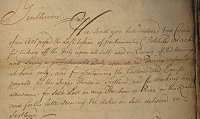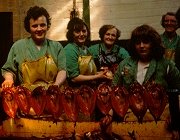Herring Home | Sale and Processing of herring | Next
Introduction to Curing: ways of preserving herring
In Scotland, different fishing communities developed their own ways of preserving herring. Some of these methods became very famous.
Red herring

Red herring are heavily salted smoked fish made by dry salting and oak smoking whole herring above wood fires in specially built smoke houses. The herring are first dry-salted. They are then washed threaded onto speets – each with 20-30 fish. The speets are stacked horizontally on racks in the smoke houses and the fish are smoked using oak shavings. The oak gives a distinctive flavour. The process of curing red herring takes at least 10 days.
White herring
This was by far the most widely used method of preserving herring and was known as curing. The Dutch mastered this technique in the 16th century. It involved gutting and salting the herring and packing it in barrels. The process was organised by a curing firm and took place in curing yards by the harbour. Teams of women did the gutting and packing while the men worked as coopers and carters. Once the herring was gutted, salted and packed in barrels it was checked by the fishery officer. Finally, it was ready for export. Often these teams of workers would follow the fishermen as they caught herring at different places around the coast.
Kippers

Kippers are herring that are split open before curing. The split and gutted fish are thrown into large flat baskets. They are then washed, cleaned and soaked in brine for about an hour. After soaking in brine they are hung 8 or 9 herrings each side, on square bars of wood with hooks along each side known as 'kipper speets'. Finally, they are stacked in racks over the 'loves' of a smoke house fuelled by oak shavings and sawdust for at least 12 hours.
Bloaters
Bloaters are ungutted and salted herring slightly smoked. They became popular in the 19C. Those for the home market were lightly salted by immersion in brine for a couple of hours and then dried (not smoked) in a smoke house for one night. Bloaters for the foreign market were salted in tanks for at least 5 days and then smoke-dried for 2 days. Latterly most were exported to the Mediterranean.